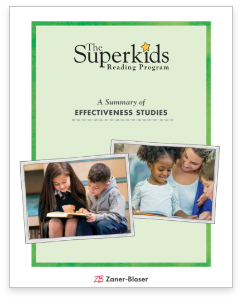Flourishing in Schools and Districts Nationwide
Educators across the U.S. are creating success with The Superkids Reading Program, and the results are measurable. Dig into the efficacy data and case study results below for proof of the reading program’s impact on student achievement.
To bring this success to your school or district, contact us for more information about The Superkids Reading Program.
Request Information
A Splendid Success, Gurnee School District
56 in Illinois
Science-Based Reading Instruction with Superkids in Illinois
Sacred Heart Villa and The Superkids Reading Program
New Jersey Superkids Success
Case Studies: Superkids Schools Share Their Successes
Watch the case study videos and read the case study reports to discover how districts large and small, from California to Missouri to New York, are achieving results.
Every school has had a unique experience with diverse populations of students, and most have shared impressive data as well. Explore their stories.
CALIFORNIA: Diocese of Fresno
Read Case Study
COLORADO: Littleton Public Schools
Read Case Study
COLORADO: School District 27J
Read Case Study
FLORIDA: Hillcrest Elementary
Read Case Study #1 Read Case Study #2
ILLINOIS: Bellwood School District 88
Read Case Study
ILLINOIS: Gurnee School District 56
Read Case Study
MISSOURI: Matthews Elementary School
Read Case Study
OHIO: Perry Elementary
Read Case Study
OHIO: St. Boniface School
Read Case Study
OKLAHOMA: Will Rogers Elementary School
Read Case Study
TENNESSEE: Cocke County School District
Read Case Study
TENNESSEE: Diocese of Knoxville
Read Case Study
VIRGINIA: Scott County Public School Division
Read Case Study
WISCONSIN: Northland Pines School District
Read Case Study
WISCONSIN: Wausau School District
Read Case Study
WISCONSIN: School District of Wisconsin Dells
Read Case Study
Efficacy Research
A large body of evidence shows that The Superkids Reading Program is highly effective in improving reading achievement for K–2 students of all backgrounds in all types of schools.
According to Evidence for ESSA, Superkids features two quasi-experimental studies that “found significant positive outcomes on measures of sound and word reading.” These studies qualify the program for the Moderate level of evidence necessary for funding by the Every Student Succeeds Act.
Read about the scientific research covering many years, regions of the U.S., and student populations in “A Summary of Effectiveness Studies.”
Download the Summary
Independent Studies
The following reports present studies conducted by independent researchers into the effectiveness of Superkids.
Study by Ohio State University Professor Shows Strong Effects for SuperkidsPeer-reviewed Scientific Study Confirms Superkids Superior Results
Superkids Students Dramatically Outperform Control Group
Three-year Longitudinal Study Shows Impressive Gains for 1,800 Superkids Students
Independent Researchers Discover Rapid Student Progress With Superkids
Rowland Reading Foundation Studies
Rowland Reading Foundation, a nonprofit organization and the former publisher of Superkids, conducted the research studies below.
Third-grade Scores Improve Dramatically for Students Taught With Superkids in K–2Catholic Students Achieve Superior Results in National Study of Superkids
Lutheran Schools in Nationwide Trial of Superkids Achieve Extraordinary Results
Study Shows Superkids Program Is Highly Effective With Beginning Readers
